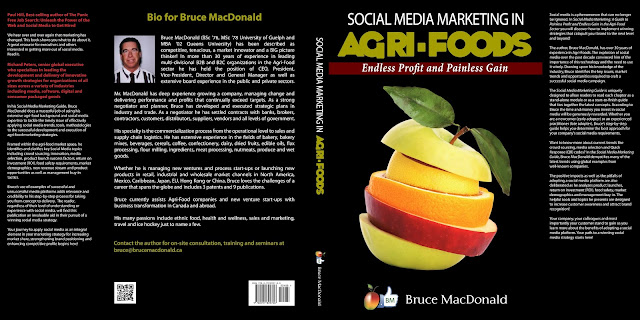FAO SAYS WORLDWIDE MALNUTRITION, HUNGER UNACCEPTABLE
Published June 5, 2013 in Food Product Design
Check out my latest e-book entitled: "Social Media Marketing in Agri-Foods: Endless Profit and Painless Gain".
ROME—In keeping with the promise made when he took office in January 2012, U.N. Food and Agricultural Organization Director-General José Graziano da Silva on June 4 called for resolute efforts to eradicate malnutrition and hunger from around the world. He said the social and economic costs of global malnutrition unacceptable.
In a recorded statement marking the launch of FAO's flagship annual publication The State of Food and Agriculture (SOFA), Graziano da Silva said although the world has registered some progress on hunger, one form of malnutrition, there was still "a long way ahead."
"FAO's message is that we must strive for nothing less than the eradication of hunger and malnutrition," he said.
The “Food Systems For Better Nutrition" report notes that although some 870 million people were still hungry in the world in 2010-2012, this is just a fraction of the billions of people whose health, wellbeing and lives are blighted by malnutrition. In fact, 2 billion people suffer from one or more micronutrient deficiencies, while 1.4 billion are overweight, of whom 500 million are obese, according to SOFA. Twenty six percent of all children under age 5 years are stunted, and 31% suffer from vitamin A deficiency.
The cost of malnutrition to the global economy in lost productivity and health care costs are "unacceptably high" and could account for as much as 5% of the global gross domestic product—$3.5 trillion dollars, or $500 per person. That is almost the entire annual GDP of Germany, Europe's largest economy.
In social terms, child and maternal malnutrition continue to reduce the quality of life and life expectancy of millions of people, while obesity-related health problems, such as heart disease and diabetes, affect millions more.
To combat malnutrition, SOFA makes the case that healthy diets and good nutrition must start with food and agriculture. The way we grow, raise, process, transport and distribute food influences what we eat, the report says, noting that improved food systems can make food more affordable, diverse and nutritious.
Specific recommendations for action include:
In a recorded statement marking the launch of FAO's flagship annual publication The State of Food and Agriculture (SOFA), Graziano da Silva said although the world has registered some progress on hunger, one form of malnutrition, there was still "a long way ahead."
"FAO's message is that we must strive for nothing less than the eradication of hunger and malnutrition," he said.
The “Food Systems For Better Nutrition" report notes that although some 870 million people were still hungry in the world in 2010-2012, this is just a fraction of the billions of people whose health, wellbeing and lives are blighted by malnutrition. In fact, 2 billion people suffer from one or more micronutrient deficiencies, while 1.4 billion are overweight, of whom 500 million are obese, according to SOFA. Twenty six percent of all children under age 5 years are stunted, and 31% suffer from vitamin A deficiency.
The cost of malnutrition to the global economy in lost productivity and health care costs are "unacceptably high" and could account for as much as 5% of the global gross domestic product—$3.5 trillion dollars, or $500 per person. That is almost the entire annual GDP of Germany, Europe's largest economy.
In social terms, child and maternal malnutrition continue to reduce the quality of life and life expectancy of millions of people, while obesity-related health problems, such as heart disease and diabetes, affect millions more.
To combat malnutrition, SOFA makes the case that healthy diets and good nutrition must start with food and agriculture. The way we grow, raise, process, transport and distribute food influences what we eat, the report says, noting that improved food systems can make food more affordable, diverse and nutritious.
Specific recommendations for action include:
- Use appropriate agricultural policies, investment and research to increase productivity, not only of staple grains like maize, rice and wheat, but also of legumes, meat, milk, vegetables and fruit, which are all rich in nutrients.
- Cut food losses and waste, which currently amount to one third of the food produced for human consumption every year. That could help make food more available and affordable as well as reduce pressure on land and other resources.
- Improve the nutritional performance of supply chains, enhancing the availability and accessibility of a wide diversity of foods. Properly organized food systems are key to more diversified and healthy diets.
- Help consumers make good dietary choices for better nutrition through education, information and other actions.
- Improve the nutritional quality of foods through fortification and reformulation.
- Make food systems more responsive to the needs of mothers and young children. Malnutrition during the critical ‘first 1,000 days' from conception can cause lasting damage to women's health and life-long physical and cognitive impairment in children.
Check out my latest e-book entitled: "Social Media Marketing in Agri-Foods: Endless Profit and Painless Gain".
The book is available on Amazon and Kindle for $4.99 USD. Visit amazon/Kindle to order now:
http://www.amazon.ca/Social-Media-Marketing-Agri-Foods-ebook/dp/B00C42OB3E/ref=sr_1_1?s=digital-text&ie=UTF8&qid=1364756966&sr=1-1
Written by Bruce MacDonald, a 30 year veteran of the Agri-food industry, in "Social Media Marketing in Agri-Foods: Endless Profit and Painless Gain", Bruce applies his background and expertise in Agri-foods and social media to the latest trends, tools and methodologies needed to craft a successful on-line campaign. While the book focuses on the Agri-food market specifically, I believe that many of the points Bruce makes are equally applicable to most other industries.


No comments:
Post a Comment